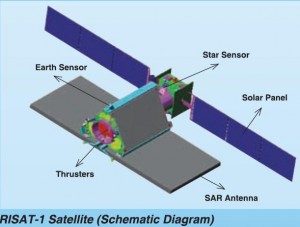The eye of RISAT – 1 is ‘made in Ahmedabad’
April 26, 2012
Ahmedabad, 26 April 2012
 It is a matter of pride that Synthetic Aperture Radar (SAR), the main part of RISAT-1 satellite is ‘made in Ahmedabad’.
It is a matter of pride that Synthetic Aperture Radar (SAR), the main part of RISAT-1 satellite is ‘made in Ahmedabad’.
RISAT-1 was successfully launched today morning by Indian Space Research Organization(ISRO).
The main payload of RISAT is a Synthetic Aperture Radar (SAR), operating in C-band (5.35 GHz). This payload, developed at Ahemdabad based Space Application Center(SAC) of ISRO, works like an eye of the satellite and enables imaging of the earth surface features during both day and night under all weather conditions.
Active Microwave Remote Sensing provides for cloud penetration and day-night imaging capability. These unique characteristics of C-band Synthetic Aperture Radar enables applications in agriculture, particularly paddy monitoring in kharif season and management of natural disasters like flood and cyclone.
-It is the first such machine India has built on its own.
-While most remote sensing satellites need light to snap pictures, RISAT uses microwaves – similar to the ones in your kitchen oven.
-Just like your camera fires a flash of light, RISAT-1 fires microwaves, which the ground reflects back. A radar inside the satellite uses those reflections to make pictures so clear, that from six hundred kilometers above, the satellite can tell what car you’re driving.
-Because it doesn’t need light, RISAT works both by day and night, in cloudy conditions and crucially, they see you even if you’re hiding under trees, in forests. That makes them useful for the military. ISRO officials however clarify that this satellite would not be used for defence applications. RISAT-2, primarily a spy spacecraft, is already doing that job.
-Officially, pictures from RISAT-1 will be used to estimate the number of hectares being farmed in India, to assess crop health and predict total yield. It can also be used for disaster management during cyclones and floods. They can also be used to identify wreckage from airplanes that go down in forested areas.
-India has launched similar Israeli satellites earlier. The first, called Tecsar, was launched in January 2008 and the second, RISAT-2 went up in April 2009. While Israel uses the images from Tecsar, India uses the feed from RISAT-2.
-The fabrication and launch of RISAT-1 was postponed in the aftermath of the 2008 Mumbai attacks in order to prioritize the launch of RISAT-2 with its X-band SAR of Israeli origin.
-The 1,858 kg spacecraft, the country’s first microwave remote sensing satellite, was injected into orbit by the Polar Satellite Launch Vehicle about 19 minutes after a perfect lift off at 5.47 am at the end of the 71-hour countdown from the Satish Dhawan Space Centre here, around 90 km from Chennai.
-The approved cost of RISAT-1, including its development, is Rs. 378 crore, while Rs. 120 crore has been spent to build the rocket (PSLV-C19), making it a Rs. 498-crore mission.
-The spacecraft, which would be parked at its final orbit of 536 km altitude, has a mission life of five years and would make 14 orbits per day.
Brochure of PSLV C-19 and RISAT-1 in PDF
Recent Stories
- 24 hours rainfall data from across Gujarat; Central Gujarat, Kutch top the chart
- High-level review held in national capital to fast-track infra projects worth ₹36,296 cr in Gujarat & Rajasthan
- How to get Learning Licence without visiting RTO in Gujarat ?
- Swarm of bees delays Indigo flight at Surat Airport by an hour
- NHAI carries out major repair on Vadodara – Bharuch stretch of National Highway 48
- Saputara Monsoon Festival ‘Megh Malhar Parv’ set to begin from July 26
- BMW car catches fire near Vapi GIDC, driver escapes unhurt
